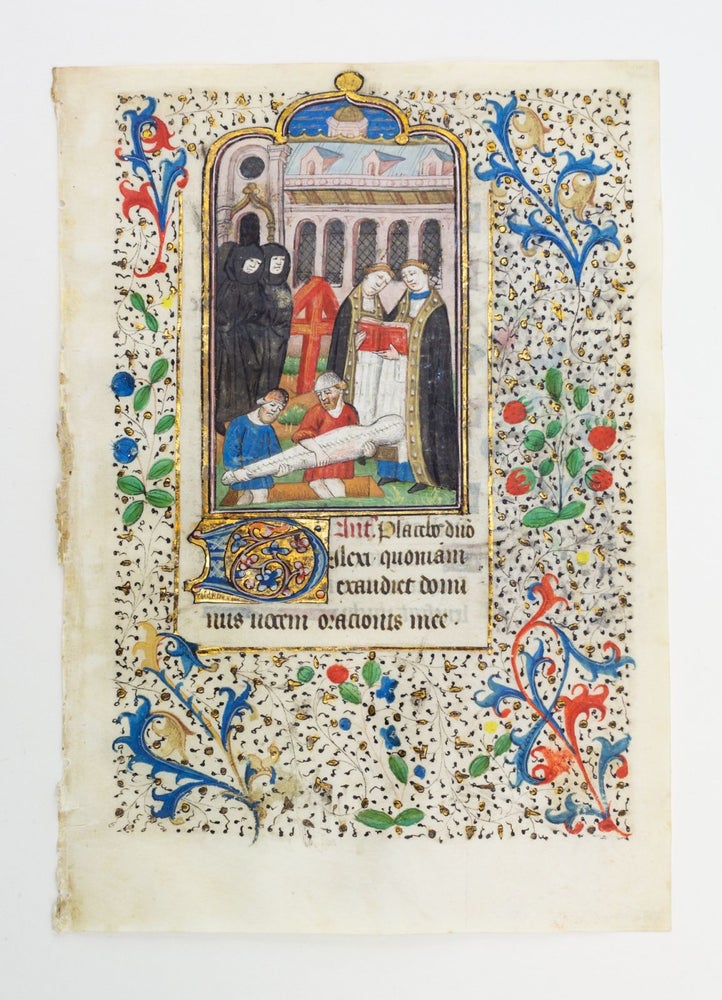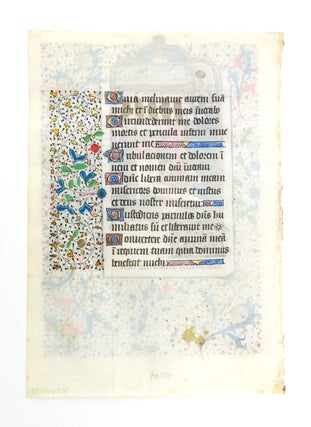TEXT FROM THE OFFICE OF THE DEAD.
(France [probably Besançon]: 3rd quarter of 15th century). 239 x 165 mm. (9 3/8 x 6 1/2"). Single column, 15 lines in an elegant gothic book hand.
Rubrics in dark pink, line-enders in dark pink and blue with a gilt bezant, several one-line initials in burnished gold on dark pink and blue ground with white tracery, one three-line initial in blue with white tracery, filled with flowers painted pink or blue, all on a gold ground, verso with panel border of delicate hairline vines terminating in gilt bezants and ivy, and with a spray of blue flowers and a red bud, recto with A FULLY-REALIZED HALF-PAGE MINIATURE OF A BURIAL in an arch-topped gilt frame, with two laymen lowering a shrouded corpse into the ground, a small group of hooded monks to the left and two ecclesiastical figures reading from a book to the right, all in front of a gothic church painted pink with a blue roof, SURROUNDED BY A FULL BORDER consisting of hairline vines terminating in gold bezants and ivy, colorful acanthus, strawberries, and blue flowers, the text below the miniature further framed with a thin "U"-shaped line extending the full height of the miniature. ◆A very few trivial imperfections (quite minor wear to paint on clothing, a little insignificant smudging, one small, light stain in the blank margin of verso), but these defects not the least distracting, and overall the miniature in fine condition, with rich, well-preserved color.
This is a splendid miniature from a particularly large Book of Hours, showing a detailed rendering of a scene from contemporary Medieval life--that of a burial in a churchyard involving clergy, mourners, and laymen. Apart from those relatively few copies with illustrated calendars, the miniatures found in Books of Hours are almost entirely devoted to retrospective Bible scenes that are obviously outside the experience of the illuminator; it is only in the present kind of scene at the beginning of the Office of the Dead that we can see a contemporaneous image that would have come directly from the Medieval experience. While our painting is fairly typical in subject matter and design, it offers a number of interesting details about the Medieval rites and rituals surrounding death. The present scene represents the final stage (preceded by the funeral procession, Requiem Mass, prayers, Absolution, and the procession into the graveyard) in which the body is actually laid to rest in the ground. Though the corpse would have been encased in a coffin during the aforementioned rites and processions, it was customary to bury the dead in only a shroud (in the present example, the artist has even thought to show the stitching along the length of the shroud). Three groups of people, each serving a different function, appear in this miniature: in the foreground are two laborers lowering the body into an earthen grave, a small group of mourners in black cloaks stand off to the left, and a duo of clergy members stand to the right. The latter have tonsured heads, and each wears a black cope (donned prior to administering Absolution to the deceased); together, they hold a manuscript containing the Rites for Burial. The background is composed of a grand church or cathedral containing a number of fine architectural details, including several windows (including a clerestory level), an arched entrance, a dome, and decorative touches. Stylistically, this leaf can be localized to the Franche-Comté region in eastern France, and is closely related (if not directly attributable) to an atelier specializing in Books of Hours made for the Use of Besançon and most likely situated in that city (see Avril and Reynaud, p. 197). The similarities are especially apparent in the figures' faces, which are slightly puffy in appearance and have distinct, slit-like eyes. As noted by Avril and Reynaud, the unnamed master of this atelier was deeply indebted to the Master of Morgan 293, a talented Burgundian illuminator active in the second quarter of the 15th century, whose name derives from a particularly lovely Book of Hours made for the Use of Besançon. Whoever the artist responsible for the present miniature, this work is an excellent representation of a distinct regional style, extremely attractive, and replete with interesting details that connect us to the Medieval experience. (ST17060V)
Price: $8,500.00


